LG 29EA93 Monitor Review - Rev. 1.25
by Chris Heinonen on February 12, 2013 8:49 PM ESTOnce again we are copying our charts from our Tablet and Smartphone workflow here for monitors. As I mentioned earlier, you can’t compare these to prior results due to the use of dE2000 for numbers. Another key change here is the ability to use meter profiling for doing measurements, which I’ll elaborate on here a bit to put these numbers into context.
There are two main types of meters: colorimeters and spectrometers. Colorimeters are usually cheaper, and use color filters to read the different colors of light. Spectrometers often cost more but actually “read” the light instead of using filters. This difference is key as color filters were very good when the only light sources were CRTs or CCFL lamps, but now with White and Multi-colors LEDs, and OLED displays, we have light with a different spectral makeup than before, which the filters are often not designed around. This can cause a colorimeter to have incorrect readings but a spectrometer will not.
The reason we don’t always use spectrometers is because they are much slower, and they read at low light much worse that a colorimeter. With meter profiling, you use a spectrometer and colorimeter to read colored patches from a display, and then the software analyzes the results. This creates a 3x3 correction matrix for the colorimeter that then allows it to correctly read the light from the display, even if it is LED or OLED based. The key thing here is this now allows us to read shadows better, and do more readings to produce better results.
The main area of difference here is going to be in blues. Compared to 100% White, 100% Blue has only 7% of the light output, making it very dim. This makes it harder to read for a spectrometer, which makes it more prone to error. Now that we can use a profiled colorimeter to make this reading, and in my case use a C6 meter that can average 10 results at a time to produce a more accurate number, our blue numbers may be different than before, but they will be more accurate.
| Pre-Calibration | 200 cd/m² Target | 80 cd/m² Target | |
| Primary and Secondaries dE2000 | 2.3002 | 1.4839 | 2.0847 |
| Colorchecker dE2000 | 2.1689 | 1.0185 | 0.9915 |
| Saturations dE2000 | 1.7017 | 1.0126 | 1.1254 |
With that out of the way, we can look at the CIE gamut chart and see that the LG 29EA93 has a bit more than the sRGB gamut available, with reds and greens that extend beyond the CIE triangle. Pre-calibration our numbers look very good, but with a bit of over-saturation in the reds and greens. The 200 cd/m² calibration numbers look better than the 80 cd/m² when it comes to the CIExy chart, but frankly I’m more concerned with the color checker and saturation charts. Most people only focus on the CIE chart, but it really just shows the performance of 6 colors and the size of the gamut, but tells you nothing about the performance of the other 16.7 million colors you might use.
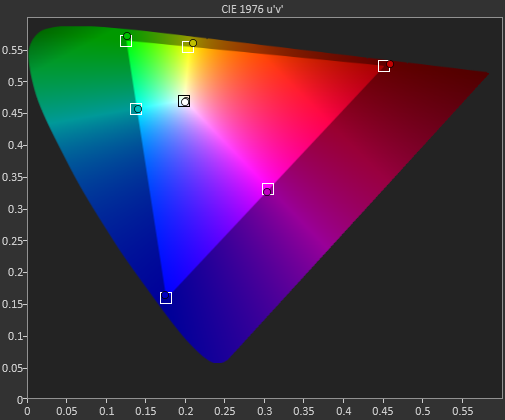
Pre-calibration, the dE2000 number for the Color Checker chart is quite good on the LG 29EA93. Until we have more monitors done with the new workflow we can’t be certain of how good this is, but overall it does look very nice. The main issues are in pure white, and those Yellow-Red-Green tones that fall at the edge of the gamut. The bit of over-saturation that we saw earlier causes these to be a bit too-rich and leads to some visible errors there.
After calibration, only those over-saturated colors provide anything to care about at all. Beyond those four points, the other 20 samples are nearly perfect, with no visible error at all even in blues. If those final four points were perfect there would be nothing to complain about at all with the LG 29EA93, but even with them it produces overall dE2000 numbers that are fantastic.
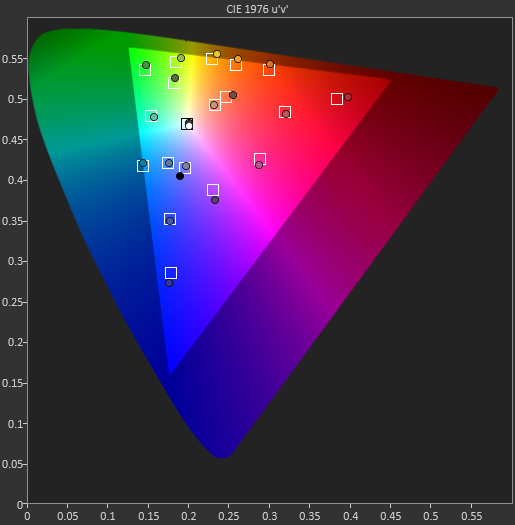
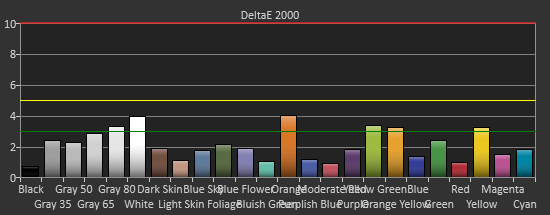
Pre-calibration, the saturation numbers for the LG are good, but you can see quite a few of the measurements are at or close to the dE2000 3.0 mark. Post-calibration this improves, especially the 20% data, with only the 100% green and yellow color swatches measuring over 3.0, and only four measurements total over a dE2000 of 2.0. The calibrations push the saturation measurements from good to excellent.
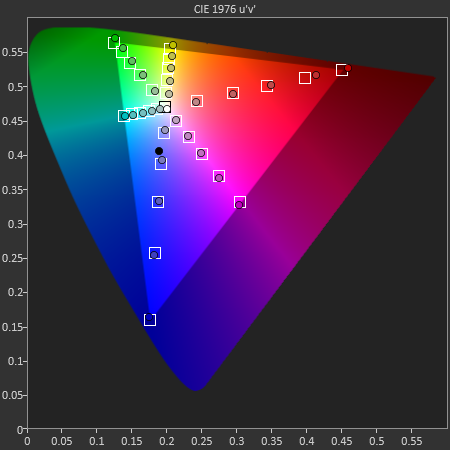
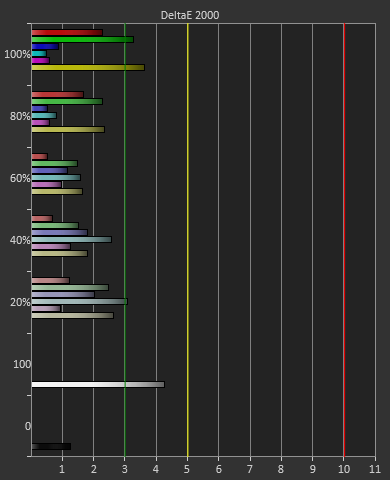
Taking these measurements in full, it seems that after calibration, the only place you will see any color errors on the LG 29EA93 is in a fully saturated red, green, or possibly yellow. As soon as the saturation drops below 100% the error level drops drastically, and you won’t be able to see an error at all. Unless you start at a pure-red screen all day long, the color of the LG 29EA93 is going to be very impressive.











108 Comments
View All Comments
cheinonen - Tuesday, February 19, 2013 - link
I don't add calibrated settings for a reason: They're specific to that display, and that one only. The level of tolerances on a consumer panel is high enough that just plugging in the settings from someone is no guarantee that the image will be better or worse, just different. And since it can be just as easily worse as opposed to better, I don't provide them. Otherwise I know it will result in many people getting those settings from somewhere else, or without a disclaimer like this, using them, and then posting "The AnandTech settings made my display worse, they have no idea what they're talking about".If the display has a mode that is more accurate, I typically mention which one I used for calibration so everyone could use that specific mode, buy beyond that and adjustments are just as likely to make a display worse as better.
SpartanGR - Tuesday, February 19, 2013 - link
Don't bother with this monitor yet. There's no 1.25 version out there.Adrianojp - Tuesday, February 26, 2013 - link
Hi,This is my first post, but I have been reading your site for years now.
Thank you for all your great work!
Response times: in your 1.25 review, you state that RT's have been tested at 1080p resolution because of some CRT limitations. Could you please iron this out for me?
I am a hardcore FPS gamer, and am out shopping for the fastest 27-30 monitor out there! This would be very interesting because of it's huge landscape, but lag is a no no!
mcfrumpy - Monday, March 11, 2013 - link
So I noticed that now Newegg and Microcenter are carrying this monitor. There's a guy on the HardOCP forums that bought one and is doing a review. The picture he took of the back shows a manufacturer date of January 2013, but a rev00. I know they weren't released in the US officially so for all I know rev00 is the 1.25 here, but seems kinda risky to buy without knowing for sure.carloverthepond - Tuesday, March 19, 2013 - link
I purchased this monitor from South Korea arrived with build date Dec 2012 Rev 00 shockingly poor panel over 30 stuck/dead/live pixels. This month I purchased one from Frys again build date Dec 2012 Rev 00, then one from MicroCenter yet again build date Dec 2012 Rev 00. The money I have lost in shipping and restocking fees is now a joke. Currently awaiting one I ordered from Newegg arrives 03/22/13 their website photos show build Feb 2013 Rev 01, so how do we know if this is revision 1.09 or 1.25. After several conversations with LG USA they posted the comment below on Neweggs website, how can you truly tell what revision you have when it's not labeled clearly and manufacturer just says it's revision 1.25 are we to take their word? If anyone has any idea how to identify which revision other than sticker on rear of panel? An LG USA have been very clear they will NOT update older revisions to their knowledge they don't even have the means to do so.Manufacturer Response:
1. The older version is neither defective nor low quality. It was just a running change to update the firmware
to newer versions (like is done with other electronics).
2. Currently, there hasn’t been any game resolution support issues reported for this model. Please contact us with
any issues you find so we can test. Our previous internal testing did not find any resolution support issues for
any games. Also, Software version is not related to resolution support and different versions do not effect ability
to support full 2560 x 1080 resolution.
3. All of models sold to newegg.com are firmware version 1.25.
Please call us with any more questions. 800-243-0000.
carloverthepond - Thursday, March 21, 2013 - link
Received new monitor today from newegg and the manufatures response is incorrect, newegg are selling revision 00. So some people get the new revision and others like me yet again get the old one. This will now be my fifth monitor, will I ever get the new revision. Is it accurate that rev 00 is really 1.09 and rev 01 is 1.25?5150Joker - Saturday, March 23, 2013 - link
Your guess is as good as mine. I picked up an LG 27EA83-D from Fry's which just recently received a firmware update of its own with similar results as the panel you bought. However mine was manufactured in Jan 2013 and is Rev 00. I wrote LG USA about it and they had no clue (surprise surprise). So right now I'm trying to get a hold of someone in Korea that can provide firm answers. Otherwise as much as I love this display, it might go back to Fry's.rogerRion - Wednesday, March 27, 2013 - link
1.09 / 1.25what do i have?
the same in germany.
A) isnt there a way to find out which revision do you really have? maybe with powerstip on the DDC data?
B) is a simple Firmware Update (like on CDRW drives) possible, or is this thought technical not logical?
SpartanGR - Monday, April 1, 2013 - link
A. Unfortunately noB. No again for some reason but i strongly believe that it may well as be diff. electronics along with diff. firmware
dim.thelights - Thursday, April 4, 2013 - link
How to know which Rev. you will buy in the shop?Anyone know how to find out?